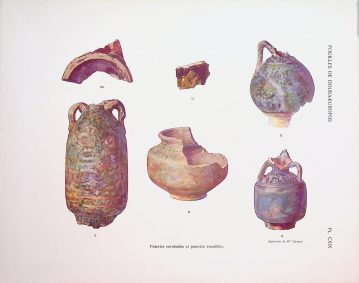Fouilles de Doura-Europos (1922-1923). Avec un appendice sur la céramique de Doura par M. et Mme Félix Massoul. TWO VOLUMES: TEXT & ATLAS.
Cumont, Franz 1868-1947.
Synopsis
Franz Cumont (1868-1947), was a Belgian archaeologist and philologist who strongly influenced the modern Protestant school of the history of religions through his fundamental studies, particularly on Roman pagan cults.
His expeditions to Syria and Turkey for astrological research led to discoveries of drawings and inscriptions on monuments and revealed a significant relation between the Mediterranean cult of Mithra and the Eastern practice of Zoroastrian Mazdaism. [Britannica.com].
Dura-Europos was a Hellenistic, Parthian and Roman border city built on an escarpment 90 metres above the right bank of the Euphrates river. It is located near the village of Salhiyé, in today’s Syria. In 113 BC, Parthians conquered the city, and held it, with one brief Roman intermission (114 AD), until 165 AD. Under Parthian rule, it became an important provincial administrative centre. The Romans decisively captured Dura-Europos in 165 AD and greatly enlarged it as their easternmost stronghold in Mesopotamia, until it was captured by the Sasanian Empire after a siege in 256–57 AD. Its population was deported, and after it was abandoned, it was covered by sand and mud and disappeared from sight.
Dura-Europos is extremely important for archaeological reasons. As it was abandoned after its conquest in 256–57 AD, nothing was built over it and no later building programs obscured the architectonic features of the ancient city. Its location on the edge of empires made for a co-mingling of cultural traditions, much of which was preserved under the city’s ruins. Some remarkable finds have been brought to light, including numerous temples, wall decorations, inscriptions, military equipment, tombs, and even dramatic evidence of the Sassanian siege.








